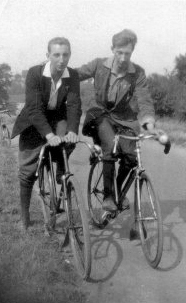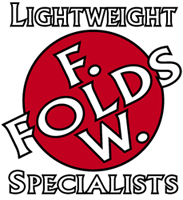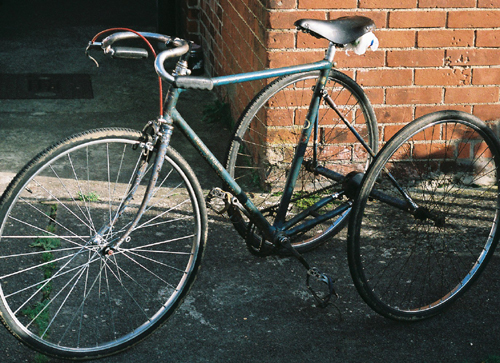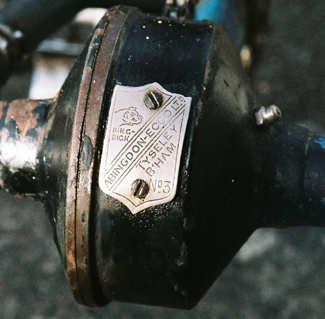Folds, F W 'Freddie'
Posted: Tuesday 02nd June 2020
In 1980 I was accosted by a fellow cyclist, who subsequently became a very good friend, who asked if I was interested in buying any machines from the estate of one Tom Pearce. I went to Wallingford to look and bought a tricycle of very unusual design. (see image below) It had the transfers of Freddie Folds and featured a huge, ungainly bridge between the half-axles of which more later.
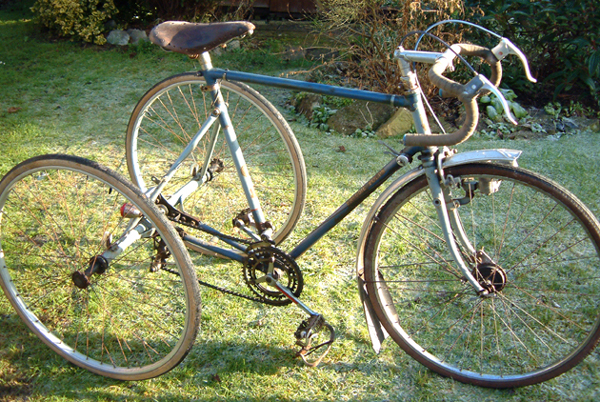
I tried to find out who Folds was and the best answer I got was, ‘the name rings a bell’! Some years later I was casually given some old copies of the Tricycle Association Gazette from the ‘50s. These laid about the house until one day I picked them up and began perusing them. This next bit is hilarious – I was reading them, late at night, in bed, and my wife Ann is trying to sleep. Suddenly I realise I am reading a description of my unique tricycle and without hesitation I assumed Ann would be just as fascinated. She wasn’t, but somehow we remain friends!
“Other members may be interested in the description of an axle I have recently made for myself. It is a well-known fact that a tube is more resistant to twist than the solid bar, as well as being lighter in weight, and some of the solid axles certainly twist quite a bit, as I discovered when removing a tight fixed sprocket, so I decided to experiment with a tubular axle. The sleeves are 1¼” x 20g tube as used for cycle head tubes, the axle ‘shafts’ are 1″ x 18g frame tubing reinforced at each end by 7/8″ x 16g tubing brazed inside far enough to go just beyond the bearings and protruding on the outer ends for 3 inches to form the hub centres on which are brazed the spoke flanges cut from a couple of old BW No. 10 hubs. The bearings are standard cup and cone type continental head bearings, the crown races at the hub ends and the screwed races and locknuts at the inner ends. The sprocket boss is the right-hand end of a roadster hub which just slides on to the centre. The two halves of the axle are joined in the centre by a bridge which, as it had to be made to take apart for access to the bearings, is a little on the hefty side, thereby minimising what weight I may have saved on the rest of the job. I have given it a fair amount of use and am quite satisfied with its performance, the drive is certainly very rigid. I think the bearing will wear fairly well – after all they are really more suited to rotary action than to the end-on bashing that they get in a head.”
Later again John Pinkerton remembered my trike and sent a cutting from Cycling of 1934 in which Folds outlines a suggestion, complete with illustration, of a novel, short wheelbase bicycle whereby the rear wheel has room to protrude between twin down tubes. The design was exactly like a Saxon twin-tube with which many of us are already familiar and an example of which by coincidence I already had. The letter in Cycling included Folds address in Southbourne near Bournemouth so I was able to find his entry in relevant street directories. He seems to have been there from 1935 until 1959 when he died. Having been born in 1902 he was only 58 years old when he passed away.
Then Chris Hewitt, the TA member and repairer, obtained the pictures of Freddie herewith and some memories of him from his former clubmates from the Verulam CC. Apparently Freddie lived on ‘The Heath’ in St Albans and worked as a baker. His name is on the Verulam 50 mile trophy.
More recently, my cousin, a member of Bournemouth Arrow CC, introduced me to W George Bolton. I was thrilled to discover that George knew Freddie Folds and also had some of his bikes. I heard that Freddie was not only a member of Bournemouth Arrow but at one time was their Club Captain. Naturally, Arrow members patronised his shop and George has some fascinating reminiscences of Folds, such as the distinct impression he got that Fred didn’t build bikes for just anyone. George felt you practically had to pass muster before he would put you on the list.
Certainly Folds’ products that I have inspected were painstakingly made, the lug-work especially being the smoothest I have even seen. Freddie didn’t spend time on decorative embellishment; he just made the edges invisible. Obviously this care was not available to just anyone with mere money.
George also thought that Freddie’s wife had worked for Hercules and had learned to build wheels there. This skill she contributed to the business in Parkwood Road, Southbourne.
Shortly George gave me copies of The Reflector, the magazine of Bournemouth Arrow CC, in which Fred had written articles, entitled ‘I Remember’ and in which he also advertised his business. Even, I’m glad to see, promoting his short wheelbase machine, ‘Freddie’s Special’ – Something new, 37½” wheelbase, weight with steels 24½ lbs. Were any ever sold? Where are they now?
In one article Freddie describes riding with the Century Road Club and Valerie Elsden found his dates with that club – 1st November 1926 to 7th January 1929. His address at the time he joined was 16 Dalton Street, St Albans. He gained club trike record for 25 miles on 15 May 1927 with 1.20.03 and did a 2.15.20 in a 50 on 24 July 1927. This three-year stint with the Century must have pre-dated the Verulam years. Perhaps he left when Verulam CC was founded? Can anybody verify this?
On the subject of clubs, I found in The Boneshaker No. 1 that Freddie Folds joined the Southern Veteran-Cycle Club in 1955, the first year of its existence. His number was 43, so he was quick to support our Club and practically a founder member.
Just recently I have been delighted to discover another tricycle, which to my mind must be another of Freddie’s personal machines. Bill Ives’ Abingdon diffed machine (images below) is so similar to mine regarding colour, equipment and finish and coincidentally is also said to have come from the Oxford area as did mine. I know of no other Oxford connection with Folds, but surely two of his personal trikes being found near that city must be more than coincidence?
Below: Bill Ives F W Folds Tricycle – believed 1930’s
N Nicklin, another member of Bournemouth Arrow, in Fellowship News of December 1981 explains that Folds died in September 1959, having collapsed and died while cycling in the Hemel Hempstead area. What a way to go! Andy Burnet of Verulam CC recalled that Freddie’s ashes were taken, in their casket, on a clubrun, to be scattered at the Bidlake Memorial. I wonder why Freddie’s ashes were taken back to St Albans from Southbourne. Did he request it I wonder?
Posted: Tuesday 02nd June 2020
This article appears in the following categories.
Upcoming Events
Whether you are looking for a gentle social meet up, or a 100-mile ride browse the community’s upcoming events and plan your next weekend outing.


